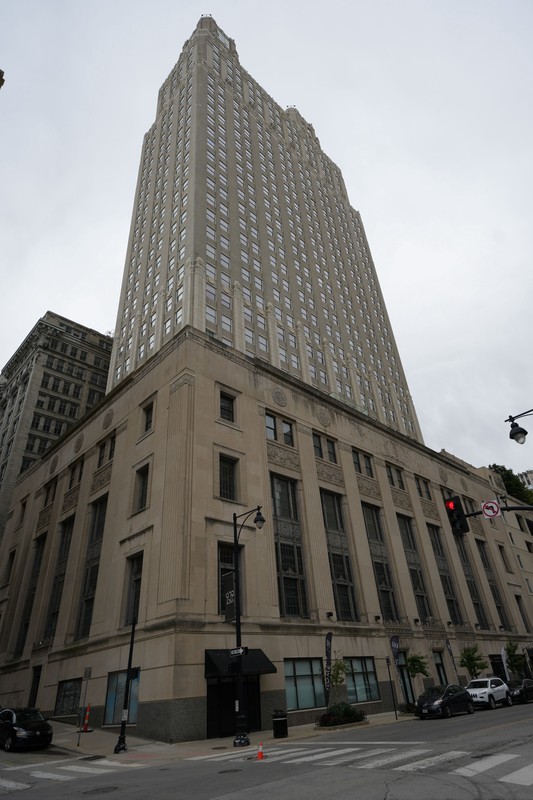Fidelity Building; 909 Walnut
Introduction
Text-to-speech Audio
Reaching a height of 465 feet (35 stories), the former Fidelity National Bank & Trust Building, which is now known as 909 Walnut, was built in 1932 and is an excellent example of Art Deco architecture. Kansas City became one of the twelve Federal Reserve bank cities in 1914, and this building , together with other downtown banking headquarters buildings, symbolized Kansas City's status as a banking center. This section of downtown is still known as the Financial District even though the city’s Federal Reserve Bank, which was located one block east, relocated to Penn Valley Park. This building is also no longer a center of finance either, as Kansas City's Fidelity National was one of many banks that closed in the early years of the Great Depression. The federal government occupied the building from 1946 to 1995, and during that time, it was called the Federal Office Building. The building represents the transition from Neoclassical architecture to Art Deco. The building features a four-story base with fluted pilasters, a series of setbacks, terra cotta decorative elements, and square towers, one of which housed the original town clock. Reflecting the history of downtown Kansas City, the building was vacant in the late 1990s and early 2000s. With more businesses, restaurants, retail, and companies returning to the downtown area, the iconic landmark was converted to apartments with a neighboring parking garage with a rooftop garden.
Images
This landmark is the former Fidelity National Bank & Trust Building, which was built in 1932 and is now an apartment building called 909 Walnut.

The building was added to the National Register of Historic Places in 1997.

Backstory and Context
Text-to-speech Audio
Fidelity National Bank & Trust was founded in 1899 and first located in the nearby New York Life Building. It grew quickly and in 1902 bought the Kansas City Post Office Federal Courts building, which housed the town clock. The bank's success continued and it was apparent that more space was needed. As a result, additions were built in 1913 and 1917. In 1919, the bank merged with National City Bank of Kansas and merged with others in 1929 and 1930. During these years, the bank's employees were housed in three buildings in the financial district. To consolidate them in one place, the bank decided to build a new headquarters.
To showcase its success as a financial institution and stature as the leading bank in the city (it was also ranked the 100th largest bank in the country in 1931), the bank spared no expense on the new building. It hired local architecture firm Hoyt, Price, and Barnes to design it with two stipulations: the building had to be classical in design and have two towers. Construction began in 1930 and was finished two years later, becoming the centerpiece of the financial district and a prominent landmark. The base of the building was designed in the Classical style while the rest of the building was designed in the Art Deco style.
Unfortunately, the bank did not survive the Great Depression and failed one year after the building opened. However, banking activities resumed in 1935 and continued until the federal government bought the building in 1946. An investment group acquired it in 1995 or 1996 but no work was done and it remained vacant for several years until a new owner bought the building in 2001 and converted it into apartments. The original address number was 911 but in the aftermath of the September 11th attacks, the number was changed to 909.
Sources
Bakewell Lowery, Adrea & Hughes, Laura. "Fidelity National Bank & Trust Building." National Park Service - National Register of Historic Places Nomination Form. August 14, 1997. https://mostateparks.com/sites/mostateparks/files/Fidelity%20National%20Bank%20and%20Trust%20Co.%20Bldg.pdf.
Davis, Jim. "Developer calls for help with 911 building." Kansas City Business Journal. April 29, 2001. https://www.bizjournals.com/kansascity/stories/2001/04/30/story2.html.
James, Darrell L. "Fidelity Tower." KC History Guy. June 6, 2009. http://kchistoryguy.blogspot.com.
Photo by David Trowbridge
Photo by David Trowbridge
